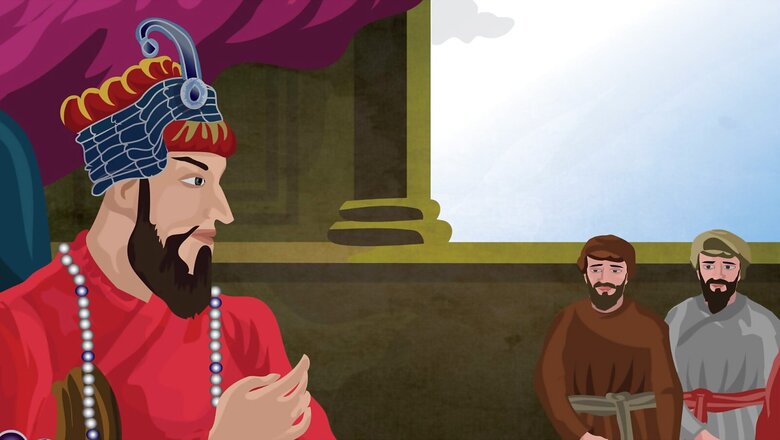
views
It has been a year since unprecedented violence took place in West Bengal after the Assembly election results were announced. Why Bengal has been suffering violence (both West Bengal and Bangladesh)? What was the original demographic composition of Bengal and how it has changed; and how this has affected the socio-political milieu in this region? This multi-part series would attempt to trace the origin of socio-political trends in the larger Bengal region (state of West Bengal and Bangladesh) over the last several decades. These trends are related to the evolution of Bengal over the last 4000 years. It’s a long journey and unfortunately most part of it has been forgotten.
The infamous Battle of Plassey that was fought on June 23, 1757 by what many call ‘the last independent Nawab of Bengal’ Siraj-ud-Daulah was another turning point in the history of Bengal as it paved the way for sale of almost whole of East India to the East India Company; the region was later colonised by the British government.
While much has been written and discussed about how Bengal landed itself into the clutches of the British colonial rule, what we often miss out is the atmosphere prevailing at that time that later provided a fertile ground for strengthening of Muslim fundamentalism.
Many historians tend to interpret the lack of education and some radical Islamic movements in the 18th and 19th century as the key cause for emergence of Muslim fundamentalism in Bengal. But fact of the matter is that Muslim fundamentalism was already there even before the British had colonised Bengal. What happened during the colonial rule was that the British consciously nurtured this Islamic radicalisation to take it to the next level.
There is also a need to bust another myth in our history textbooks which often project Siraj-ud-Daulah as a patriot and an innocent victim of palace politics, a man who fought valiantly against the British. Some of the literary works on him have done away with his flaws and projected him as a hero of the freedom struggle. However, a closer look at the deeds and the character of Siraj-ud-Daulah explains how Hindu women and common people were targeted during his regime.
ALSO READ | The Bengal Conundrum: How Islamisation of Bengal Started in Medieval Times with Forced Conversion
Siraj-ud-Daulah: Patriot or Anti-Hindu Debauch?
Bhaswati Mukherjee explains in her seminal work (Bengal and Its Partition: An Untold story, Pp 16), “The tragedy to be enacted in Plassey had commenced a year earlier with the accession of the young and headstrong Siraj-ud-Daulah as the new Nawab of Bengal in April 1756 at the age of 26, with the death of his grandfather Ali Vardi Khan. Siraj had some potentially fatal flaws that would cost him his fiefdom and his life. He was capricious, impulsive, hot tempered and arrogantly disregarded advice on military and financial matters.”
Now let us try to dig a little deeper with the help of a memoir written by a French gentleman Jean Law de Lauriston, a contemporary of Siraj. There is unanimity among historians of all shades that Law was such a close friend and aide of Siraj that he could give his life to save him. In fact, Law helped Siraj in his attempt to escape and hide after he had lost the Battle of Plassey.
What Law writes about Siraj in A Memoir of the Mughal Empire reveals the true character of the Nawab of Bengal: “The character of Siraj-ud-Daulah was reputed to be one of the worst ever known. In fact, he had distinguished himself not only by all sort of debaucheries, but by a revolting cruelty. The Hindu women are accustomed to bathe on the bank of the Ganges. Siraj-ud-Daulah, who was informed by his spies which of them were beautiful, sent his satellites in little boats to carry them off. He was often seen, in the season when the river overflows, causing the ferryboats to be upset or sunk, in order to have the cruel pleasure of seeing the confusion of a hundred people at a time, men, women and children, of whom many not being able to swim were sure to perish … Every one trembled at the name of Siraj-ud-Daulah.”
Noted historian Jadunath Srakar sums it up quite well (The History of Bengal, Vol. II, pp 497), “When (Robert) Clive struck at the Nawab, Mughal civilisation had become a spent bullet. Its potency for good, its life was gone. The country’s administration had become hopelessly dishonest and inefficient and the mass of people had been reduced to the deepest poverty, ignorance and moral degradation by a small, selfish … and unworthy ruling class. Imbecile lechers filled the throne; the family of Alivardi did not produce a single son worthy to be called a man, and the women were even worse than the men. Sadists like Siraj … made even their highest subjects live in constant terror. The army was rotten and honeycombed with treason. The purity of family life was threatened by the debauchery fashionable in the Court and the aristocracy and the sensuous literature that grew up under such patrons. Religion had become the handmaid of vice and folly.”
Beginning of the Bengal Renaissance
The fall of the Mughal empire in Bengal kicked off a major renaissance. According to Sarkar (Pp 498), “In the space of less than one generation, in the twenty years from Plassey to Warren Hastings, the land began to recover from the blight of medieval theocratic rule. … The dry bones of a stationary oriental society began to stir … It was truly a Renaissance, wider, deeper and more revolutionary than that of Europe after the fall of Constantinople … Bengal had been despised and thrown into the corner … in Mughal times as a ‘hell well stocked with bread’. But now … it became a path-finder and light bringer to the rest of India.”
From a political perspective, the Bengal renaissance had two important aspects – emergence of Hindu nationalism along with strengthening of Muslim separatism. These were two parallel streams whose roots lay in the way Islamic establishment practised religious bigotry during large parts of the medieval period in Bengal. It would be a folly to blame only the British for breaking the so-called ‘syncretic’ culture of Bengal. Islamic fundamentalism was always there since the invasion by Bakhtiyar Khilji in 1201 and it remained a distinct characteristic of all Islamic rulers in Bengal. However, the British did realise its potential to balkanise India and played it out in a way that resulted in two partitions of Bengal, in 1905 and 1947. More significantly, it led to a spate of communal riots. The fundamentalist tendencies had been sowed in so deeply and nurtured so well by the British as well as by the Islamic fundamentalists during the British regime that communal violence remains a major challenge even in the 21st century in this region (state of West Bengal as well as Bangladesh, which in undivided India were together known as East Bengal).
ALSO READ | The Bengal Conundrum: How Bengal Suffered under Mughal Rule and Hindus Fought for Survival
You can read other articles in The Bengal Conundrum series here.
The writer, an author and columnist, has written several books. One of his latest books is ‘The Forgotten History of India’. The views expressed in this article are those of the writer and do not represent the stand of this publication.
Read all the Latest Opinions here

















Comments
0 comment